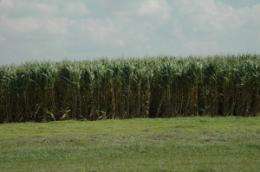Rice insects not as 'boring' in Texas, Louisiana, researchers say

(������ƵOrg.com) -- To defeat an enemy, know its lifestyle, where it works and its secret hiding places. That’s what researchers have done in a 10-year battle against two insects that bore into grassy crops such as rice, sugarcane, sorghum and corn.
“I think we’re winning the battle,” said Dr. Mo Way, Texas AgriLife Research entomologist in Beaumont. “But it’s a continuing battle, so that is why the research is needed.”
Way and a colleague, Dr. Gene Reagan, entomology professor with the Louisiana State University Agricultural Center, joined forces a decade ago – though the Mexican rice borer was found only partly across the Texas rice belt and not in neighboring Louisiana – in hopes of getting ahead of the damaging, yield-reducing pest.
Several discoveries from their work – showcased at a site visit with farmers and commodity leaders in late September – can be summed up: these once dreaded bugs are not as “boring” as when they first entered Texas from Mexico in 1980.
And that’s a good thing because, as Way and Reagan put in the proceedings from their 10th annual site visit, “the Mexican rice borer is the most destructive insect pest of sugarcane in North America” and can cause “as much as a 50-percent yield loss in commercial Texas rice fields.”
Since 1980, the Mexican rice borer has advanced about 12 miles a year through Texas and on into Louisiana where it now exists in five of that state’s parishes. Along the way, it bored into sugarcane, sorghum, rice and corn in devastating proportions.
“I remember going down to the Rio Grande Valley in 1981 or 82 and seeing sugarcane fields that were just totally brown at the end of the summer, and it didn’t make any sense,” Reagan said. “We’d go in the field and start cutting up stalks, and we’d get 20-30 larvae of the Mexican rice borer in one stalk.”
Way and Reagan knew that the pest travels as a moth and lays its eggs on leaves. The eggs hatch and larvae dig into the stalk to develop as caterpillars before feasting their way through the grassy crops common along the Gulf Coast.
So the two researchers went to the entomological equivalent of a war room – the rice and sugarcane trial fields around Beaumont – and also strung a line of snares across the region to trap and mark the pest’s advance.
“The term I would probably use is proactive. In most research programs, certainly in agriculture, we always have to do reactive work. When you have an emergency problem, you’ve got to deal with it,” Reagan said. “But if you know you’re going to have a problem in a few years, why not start making plans on how you’re going to manage and how you’re going to deal with it?”
But to complicate the matter, a similar insect, the sugarcane borer, invades the same areas and crops, yet has unique traits and lifestyle that must be controlled differently from the Mexican rice borer. So the team had to factor both pests while exploring ways for farmers to manage for the least damage to crops.
“The losses can be significant, so that’s why the farmers and the whole scientific community is involved in developing solutions,” Way said, describing how the caterpillar hides inside a stalk where typical chemicals cannot reach and eats the tissue with an appetite that grows as the insect gets bigger.
“Once they are inside thestem, they are very difficult to control because they are protected from natural control agents,” he said, “so that is one of the reasons they can be a serious pest.”
But over the years, Way and Reagan said, a “myriad number of solutions” have been proven effective for farmers to use.
Their research, funded in large part by the U.S. Department of Agriculture, has found which varieties of each crop are least susceptible to the borers, and the best time for farmers to plant to avoid the insects’ life cycle.
“The later the planting date in rice, usually the more damage,” Way said.
The researchers also discovered the cutting height on the season’s first crop of rice can impact borer populations in the second, or ratoon, crop that year.
“Basically, the lower the cutting height, the less damage from the stalk borers on the next crop,” Way said. “And that also reduces populations on an area-wide basis beyond the individual farm.”
Certain chemicals may work at specific times in the insect’s life cycle, which the researchers have determined to help farmers know whether to go to the expense of applying insecticide. Way said research determined the timing as well as the rates for chemicals in both rice and sugarcane.
Other methods that have come from the field tests include treatment of the volunteer plants along the field edges to destroy weed hosts.
“This research fits the concept of long-term management of an insect,” Reagan said. “If you’ve got an insect that feeds on a whole bunch of different plants — crops and non-crops — then you need to take into consideration all the different aspects of the biology. If you can find some vulnerable part on the biology of the insect – maybe on some crop or some weed that is necessary for it to complete its life cycle — then that might be a great opportunity for management of the insect.
“It’s going to be a continuing effort. We certainly know a lot of things we can do now. But there are always going to be other types of continuing management needs. Though we’ve conducted a lot of work so far, there still is a lot to do to manage these insects.”
Provided by Texas A&M AgriLife













